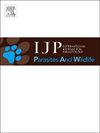European Brown hare (Lepus europaeus) as an accidental host of Trypanosoma pestanai
IF 2
3区 医学
Q3 ECOLOGY
International Journal for Parasitology-Parasites and Wildlife
Pub Date : 2025-05-07
DOI:10.1016/j.ijppaw.2025.101079
引用次数: 0
Abstract
In Europe, trypanosomes are not considered a serious threat to humans or domestic animals; however, their potential ecological impact on wildlife remains largely unknown. This study investigates presence of trypanosomes in European brown hare (Lepus europaeus) in Czechia, where this species is an important game species and plays a significant role in ecosystems. Using nested PCR targeting 18S rDNA, trypanosome DNA was detected in two of 435 blood samples, representing the first confirmation of trypanosomes in the genus Lepus. Subsequent sequencing identified Trypanosoma pestanai, a species previously reported in the European badger (Meles meles). These findings suggest that T. pestanai may have a broader host range than previously recognized, emphasizing the need for further research into its ecological impact and its potential transmission dynamics in wildlife populations.

欧洲褐兔(Lepus europaeus)是巴西锥虫的偶然宿主
在欧洲,锥虫不被视为对人类或家畜的严重威胁;然而,它们对野生动物的潜在生态影响在很大程度上仍然未知。本研究调查了捷克的欧洲褐兔(Lepus europaeus)中锥虫的存在,该物种是捷克重要的狩猎物种,在生态系统中起着重要作用。利用针对18S rDNA的巢式PCR技术,435份血样中有2份检测到锥虫DNA,首次证实在麻风属中存在锥虫。随后的测序鉴定出了巴西锥虫,这是一种在欧洲獾(Meles Meles)中发现的物种。这些发现表明,佩斯塔奈氏绦虫的寄主范围可能比以前认识到的更广,强调需要进一步研究其生态影响及其在野生动物种群中的潜在传播动态。
本文章由计算机程序翻译,如有差异,请以英文原文为准。
求助全文
约1分钟内获得全文
求助全文
来源期刊

International Journal for Parasitology-Parasites and Wildlife
Medicine-Infectious Diseases
CiteScore
3.80
自引率
5.60%
发文量
113
审稿时长
45 days
期刊介绍:
The International Journal for Parasitology: Parasites and Wildlife (IJP-PAW) publishes the results of original research on parasites of all wildlife, invertebrate and vertebrate. This includes free-ranging, wild populations, as well as captive wildlife, semi-domesticated species (e.g. reindeer) and farmed populations of recently domesticated or wild-captured species (e.g. cultured fishes). Articles on all aspects of wildlife parasitology are welcomed including taxonomy, biodiversity and distribution, ecology and epidemiology, population biology and host-parasite relationships. The impact of parasites on the health and conservation of wildlife is seen as an important area covered by the journal especially the potential role of environmental factors, for example climate. Also important to the journal is ''one health'' and the nature of interactions between wildlife, people and domestic animals, including disease emergence and zoonoses.
 求助内容:
求助内容: 应助结果提醒方式:
应助结果提醒方式:


